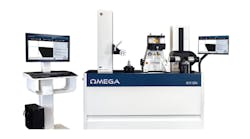Drop into any hardware store or home improvement center, and you’re likely to find aisles full of tools labeled “ergonomic.” But what exactly does that mean?
Ergonomics is the science of designing and producing tools, furniture, and other work-related implements that improve a worker’s efficiency while reducing discomfort, fatigue and the risk of injury.
Ergonomically enhanced tools can include helpful features like angled handles, padded handgrips and non-slip coatings, but no matter how impressive a tool’s design is, it’s almost impossible for it to be universally ergonomic since human physiques and project applications vary greatly from one to the next, according to Paul Holstein, chief operating officer of the Internet site CableOrganizer.com.
“Whether you’re shopping for ergonomic tools or just trying to select the right one for the job from an existing collection, the key things to consider are whether or not the tool fits your hand, how well it suits the job being done, and whether or not it eases your work and prevents you from straining in ways that could lead to injury,” Holstein said.
To make the decision process easier, Holstein’s company offers the following guidelines for choosing the right ergonomic hand tool for your body type and the job at hand:
Because finger size and placement differs from person to person, avoid using tools whose handles have built-in finger grooves. When fingers don’t naturally align with grooves, excessive pressure from the raised groove edges can cause discomfort and injury.
Choose tools with handles that are covered in a soft material, such as foam or flexible plastic.
Cushioned handles are comfortable for long hours of use and provide a firmer grip while cutting down on slippage. Hard-handled tools can be quickly and inexpensively converted by just adding a sleeve.
Ensure tool handles are free from sharp edges and seams that might irritate or cut the hands.
When selecting double-handed gripping and cutting tools, opt for ones with spring-loaded handles that will automatically return to the open position.
If you need to forcefully pinch or grip an object for an extended amount of time, prevent muscle strain by switching from standard pliers to a clamp or grip.
Only use tools that allow you to work with your wrist in a straight position.
For tasks that require force, such as torquing screws and nuts, hammering, and heavy chiseling, choose singlehandle tools with handle diameters that range from 1… in to 2 in. Larger handles allow fingers to wrap comfortably around the tool in a power grip, which prevents slippage and reduces stress and impact on hands, fingers and wrists.
For tasks that call for more precision and delicacy, such as fine chiseling and driving miniature screws, choose single-handle tools whose grips fall within the … in. to -in. range. The smaller diameter handles make it easy to comfortably grip tools between the fingertips without overexerting fingers, knuckle joints, or hand muscles.
Just as grip diameter affects work with single-handle tools, the grip span of pliers, snips, cable cutters and other double-handled tools can make a job easier or cause hand fatigue. For maximum comfort and efficiency for tasks that require more force, such as gripping with large pliers, cutting wires, or snipping through sheet metal, choose tools with a maximum “open” grip span of 3 in. and a “closed” grip span no less than 2 in. across.
Detailed jobs that involve grasping small parts and components with pincers, tweezers or tongs are best done with double-handle tools whose grip spans range from no less than 1 in. (closed) to no more than 3 in. (open).
When a work space is tight but the task at hand requires a good deal of force, opt for “power grip” tools with handle diameters from 1… in. to 2 in., which are grasped with the entire hand instead of just pinched between the fingertips. This type of grip lets you finish the job in less time, with less physical stress.
Tool length also should be matched to space constraints. Excessively long tools can force you to assume awkward work postures and wrist positions when you’re trying to reach components in cramped areas. Instead, choose shorthandled tools that give you the freedom to meet the target work area directly, while keeping your wrist straight.
The palms of your hands are full of pressure-sensitive nerves and blood vessels, and to avoid damaging these during high force tasks, it’s important to make sure that the handles of your tools are long enough that their ends won’t press into your palms. To measure, hold your hand palm-up, with fingers together and thumb against the side of your hand. As long as the tool’s handle is longer than the widest part of your hand — the span from the outer edge of your pinkie to the outer edge of your thumb — it’s safe to use.





